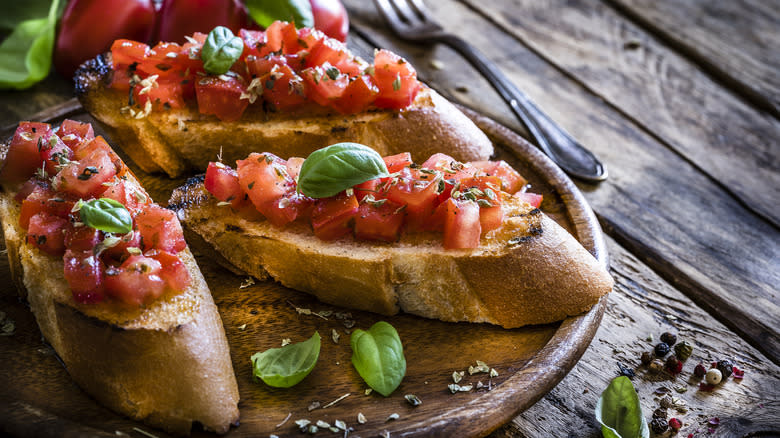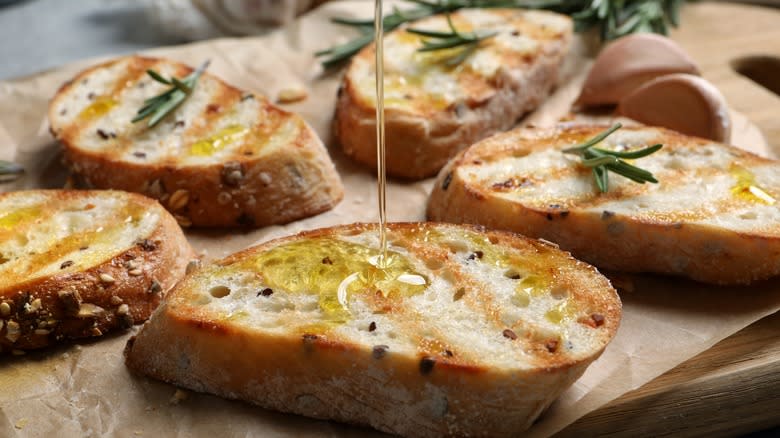The Crafty Reason Bruschetta Became A Classic Italian Appetizer

Bruschetta might be a perfect food. It's incredibly simple to make and doesn't require very many ingredients, but it's bursting with the flavor of juicy tomatoes and rich olive oil, all atop a pleasantly crispy little piece of toast. But apart from being delicious, it also has a practical purpose. The dish was initially used as a way to make use of food that might otherwise go to waste.
Zero-waste living may be very chic now, but there's nothing new about good, old-fashioned thriftiness. You probably know the frustration of buying fresh groceries, only for them to start to go bad before you can get around to using them. Early Italians weren't any different and wanted to stretch their dollar (er, coin?) as much as possible by eating food that was still safe to eat but had definitely passed its prime.
Stale bread is exactly that — eating it won't make you sick like moldy bread might, it's just not very enjoyable anymore. But bruschetta offers a solution to this: Because the bread used in bruschetta gets thoroughly toasted, it sort of disguises the stale bread's stiffness and makes it not only tolerable, but downright delightful to eat.
Read more: French Cooking Tricks You Need In Your Life
Bringing Crusty Back

Staleness itself — as long as it's not accompanied by mold or other signs of spoilage — doesn't make a food bad for you. When bread goes stale, it essentially loses its moisture, making it stiff and hard instead of soft and chewy. It might make for a pretty unpleasant sandwich, but eating it won't put you at risk of food poisoning. So, when ancient people didn't want a loaf of mostly-good bread to go to waste, they essentially dressed it up by making it into bruschetta.
As bread ages, the starch molecules gradually change form, from gelatinous to crystalline — which is to say, it becomes hard. Toasting bread actually works to reverse that process to a degree, which is why toasting stale bread gives it new life, with a fresher-seeming texture. To make bruschetta, you need to slice a baguette and then toast the slices in the oven.
It's also not uncommon to really let the toast brown, so that it acts almost as a cracker holding that delicious tomato mixture. This, in addition to the changes in molecular structure, helps to sort of mask the staleness. You perceive it as crunchy, not stiff.
Return Of The Bread

Of course, plenty of modern people also make bruschetta when they want to use up stale bread. After all, there's a reason the recipe survived from antiquity — there's no need to edit perfection. But bruschetta isn't the only well-known dish that makes use of stale bread. Panzanella is another Italian invention, and it's essentially a salad made with fresh veggies and crunchy bits of bread. Bread soups, like ribollita and French onion, serve this purpose cleverly by saturating the bread and disguising the fact that it's sort of dried out. Bread pudding and stuffing are another couple of important stale bread recipes to have under your belt, too.
In all of the above cases, the recipes work by drastically changing the texture of the bread, primarily by either toasting or soaking it. Some people actually prefer to use extremely stale bread when making these kinds of dishes, finding that it soaks up other, flavorful ingredients very effectively. But none of these other dishes can beat bruschetta when it comes to ease and simplicity — as long as you have tomatoes, olive oil, and basil, you'll never have an excuse to throw away a stale loaf of bread.
Read the original article on Daily Meal.

